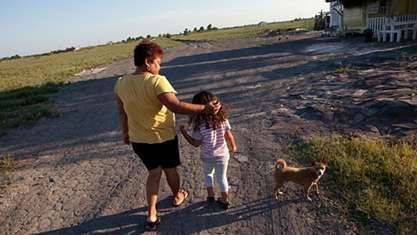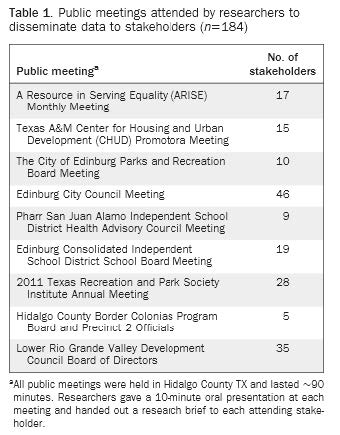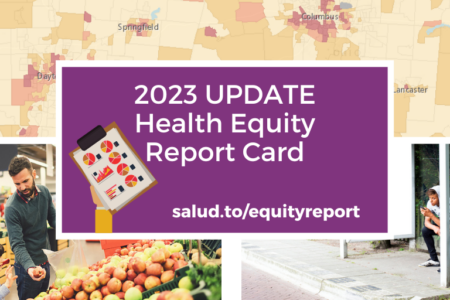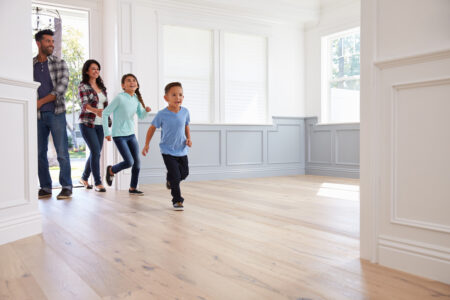Share On Social!
Not everyone has equitable access to places to play or be physically active.
That is why a housing agency advocate, fueled by locally targeted research and focus groups of homeowners, created policy to include sidewalks, hike/bike trails, and a playground to plans for an affordable housing neighborhood in a colonia, an impoverished, highly Hispanic region of South Texas.
Why Is Obesity an Issue in Colonias?
Research indicates an obesity rate of 18.1% among Mexican-American preschool -aged children living in colonias—small, impoverished settlements that often lack proper infrastructure along the Texas-Mexico border.
Colonias tend to lack sidewalks, street lights, places for recreation, and running water.
Ann Cass, director of Proyecto Azteca—a non-profit organization that works to build homes for residents in the colonias—generally was aware that improvements needed to be made to the built environment in colonias. But wasn’t truly aware of the possibilities for change, and how that change might help impact childhood obesity.

Research by Salud America! grantee Dr. Nelda Mier helped explain the possible connection between the built environment in colonias and rates of childhood obesity.
Her Salud America! pilot study, “Assessing the Built Environment in Colonias to Influence Policy Promoting Physical Activity in Mexican-American Children and Families,” found that Hidalgo County was the second poorest county in the U.S. and that 42% of the 2,294 colonias located along the Texas-Mexico border were in Hidalgo.
For her pilot study of 14 colonias located in Hidalgo County, Dr. Mier held focus groups with 67 children ages 8-13 and their parents, to learn about their perceptions on how the environment influences their levels of physical activity. She also surveyed 101 children with questionnaires and conducted an environmental audit of 125 colonia streets and 1,000 lots.
Dr. Mier found that: (1) more than 50% of area children did not get the recommended 60 minutes of physical activity a day; (2) nearly 50% were not involved in physical activity after school; and (3) 59% of the children surveyed were overweight or obese. From the focus groups that were held with children, Dr. Mier was surprised to see just how aware they were of their limited opportunities to participate in physical activity.
The children noted that they would be more active if they had street lights, parks, places to walk, and recreational facilities. They also identified some of the barriers to physical activity like trash on the streets, stray dogs, gangs, bad outdoor odors, muddy streets, speeding cars, and dirty playgrounds with rusty equipment. The results from Dr. Mier’s environmental audit showed that almost all streets lacked sidewalks, pedestrian signage, and parks.
Dr. Mier framed her findings in a research brief that explains in layman’s terms about how the colonias’ lack of infrastructure had been a barrier to physical activity.
The Idea for More Active Housing in Colonias
Because Dr. Mier wanted her research to make a difference for those living in the colonias, she decided to contact local stakeholders.
“Instead of just publishing in peer review journals, we went to the community,” Dr. Mier said.
At first she invited local stakeholders to attend meetings at the university campus. However, attendance at these meetings was low, so Dr. Mier decided to take on a new approach. She would ask to be put on the agenda of public meetings.
Dr. Mier presented her research at nine public meetings. At each meeting, Dr. Mier gave a 10 minute oral PowerPoint presentation and handed out a two-sided color sheet, with important findings from the study. After the presentation, stakeholders were asked for their feedback. In total, 74 participants responded to a survey that Dr. Mier handed out. Through this survey they provided policy recommendations and described how their institutions could contribute to solving the problem of childhood obesity in the colonias. Although she had specifically asked participants to suggest policy recommendations to improve the built environment, some suggested that sustainable healthy lifestyle programs be developed, and that community organizations be granted assistance.
Others suggested that the infrastructure be improved by repairing sidewalks and lighting conditions. Safety was also a concern and some recommended that police patrol the colonias in the evening. Respondents also stated that parks should be developed throughout the community, and that public transportation should be made available to transport children to parks.

Cass happened to be at one of Dr. Mier’s meetings. What she heard from Dr. Mier opened her eyes to the true need and potential solutions for an improved built environment in colonias.
After hearing Dr. Mier’s presentation and reading her research brief, Cass felt compelled to present Dr. Mier’s findings to the Proyecto Azteca staff, to motivate their interest in the topic so that they could work together to conceptualize ways to create healthier housing in colonias.
Eventually, Proyecto Azteca acquired funding through a variety of sources, including The Marguerite Casey Foundation. The funds would be used to build a new community of energy efficient, silver LEED-certified homes in a colonia in Edcouch, Texas.
Proyecto Azteca had previously been involved in scattered site construction; however, developing an entire community was completely new to it. Through this opportunity, the organization purchased 34 lots. Thanks to their knowledge of Dr. Mier’s research, they decided to plan to reserve two of the 34 lots to build amenities to promote physical activity among residents.
A charette, or workshop where people gather to discuss plans for development, was organized by Proyecto Azteca. Members of the board and those for whom houses would be built were invited. At these meetings, attendees were given a flyer that summarized the findings of Dr. Mier’s research. Proyecto Azteca staff members took the opportunity to talk about how the colonias’ lack of infrastructure created a barrier to physical activity, which contributed to obesity in the community.
At the charette, members from the community shared their ideas for how the new neighborhood could be better and what they could do to have a healthy community. According to Ann Cass, “future residents agreed that they needed a place for the kids to play.” The community was to be developed for a mixed population: older residents, veterans, and young families would all be living there. The possibility of having amenities such as a community garden, a hike and bike trail, a community center, a playground, and a basketball court were all discussed.
“These are things that we more than likely would have neglected in our planning had it not been for the research brief she [Dr. Mier] shared with us,” said Cass.
Bringing a New Housing Development to Reality
When Proyecto Azteca discussed its plans with city officials, it did not face any opposition.
On the contrary officials were enthusiastic about the opportunity to provide the residents with sidewalks and a playground. In fact, to extend the length of the double-wide sidewalks and hike and bike trail, Proyecto Azteca decided to contact the Cesar Chavez Foundation, an organization with property adjacent to the site where the new houses would be built. If the Cesar Chavez Foundation agreed, the two communities could be connected by a trail to provide residents with more space to walk.
Proyecto Azteca sought to give future residents what they wanted so they decided to incorporate all of the amenities that were discussed, except the community garden.
“For the time being residents wanted to have their own gardens because many of them already work on farms,” said Cass.
Double-wide sidewalks, hike and bike trails, a playground, a basketball court, and a community center were all included in Proyecto Azteca’s plans for the development. The Cesar Chavez Foundation agreed to team up with Proyecto Azteca in order to create a trail that would connect the two developments. The community is currently under construction.
If all goes according as planned, Proyecto Azteca plans to formalize its now informal policy to make such physical activity amenities the standard for all its developments in the colonias.
New Sidewalks, Playground, and More
Thanks to Dr. Mier’s research and Proyecto Azteca’s advocacy efforts residents will be able to benefit from sidewalks, a playground, a basketball court, a community center, and hike and bike trails in their new community.
So far a total of 15 houses are in the process of being built and upon completion, the first set of residents will be moving into this colonia— which will be the first of its kind. Once these homes are built concrete will be poured to create sidewalks for the neighborhood.
Proyecto Azteca’s new development and Dr. Mier’s research have helped raise awareness of the barriers to physical activity that Hispanic children in colonias face. Although Proyecto Azteca has secured two lots to build amenities, they continue to search for resources to begin building the proposed playground and community center for the Edcouch Development.
Through networking with other Salud America! researchers and interacting with the public through meetings and focus groups, Dr. Mier realized that her research has the potential to influence the development of policies, which might improve the built environment for children living in colonias.
She plans to continue spreading the word.
Members of the Equal Voice Network—a group of organizations that seek to improve the health and living conditions of those living in the colonias—have also become aware of Dr. Mier’s research and have begun to use it to reach out to policy makers. Many improvements are still needed in the colonias and these organizations continue to help colonia residents.
Meanwhile, Cass and her agency plan to spread word of the new Proyecto Azteca development in hopes that other developers make physical activity amenities a standard in their developments, too.
Proyecto Azteca also will continue to provide the community with classes and training that Cass hopes will take families from poverty to prosperity.
“The research gives our efforts credibility as we work for policy changes to make our community sustainable and healthy,” said Cass, “Dr. Mier’s research has helped us articulate what kind of policy changes we want to work for this next legislative session in Texas…that will lead to more colonias having street lights, sidewalks, and garbage collection.”
Additional links:
The Salud America! newsletter feature: “Using Research to Move Policy in Highly Obese South Texas”
A video about Life in ‘Las Colonias’ featuring Ann Cass, Director of Proyecto Azteca.
Read about previous work Proyecto Azteca has done to help improve conditions in the colonias.
Read Dr. Mier’s study “Bridging Research and Policy to Address Childhood Obesity Among Border Hispanics”.
A feature story produced by NBC Latino about Dr. Mier’s research here.
By The Numbers
56.9
percent
of Latinos are "housing cost burdened"
This success story was produced by Salud America! with support from the Robert Wood Johnson Foundation.
The stories are intended for educational and informative purposes. References to specific policymakers, individuals, schools, policies, or companies have been included solely to advance these purposes and do not constitute an endorsement, sponsorship, or recommendation. Stories are based on and told by real community members and are the opinions and views of the individuals whose stories are told. Organization and activities described were not supported by Salud America! or the Robert Wood Johnson Foundation and do not necessarily represent the views of Salud America! or the Robert Wood Johnson Foundation.



